A Robust Estimation Method of Near Infrared Brain Function Signals Based on Multi-range Measurement Method and Least Square Criterion
A measurement method and robust estimation technology, applied in diagnostic recording/measurement, medical science, sensors, etc., can solve the problems of eliminating useful information loss, aliasing part gross error, etc.
- Summary
- Abstract
- Description
- Claims
- Application Information
AI Technical Summary
Problems solved by technology
Method used
Image
Examples
specific Embodiment approach 1
[0019] Specific Embodiment 1: The method for robust estimation of near-infrared brain function signals based on the multi-distance measurement method and the least square criterion of this embodiment is specifically prepared according to the following steps:
[0020] Step 1. Use a near-infrared probe composed of a light source S and two detectors D1 and D2 to detect the position of the brain tissue to be measured;
[0021] Step 2: Detecting the diffuse reflection light intensity signal and transforming it through a photoelectric sensor to obtain an electrical signal reflecting light intensity information;
[0022] Step 3. The electrical signal obtains the time series △[HbO 2 ] N (k) and time series of changes in reduced hemoglobin concentration △[HHb] N (k), time series △[HbO 2 ] F (k) and time series of changes in reduced hemoglobin concentration △[HHb] F (k);
[0023] Step 4. Use x(k) to express △[HbO 2 ] N (k) or △[HHb] N (k);
[0024] Step 5. Use y(k) to express ...
specific Embodiment approach 2
[0030] Specific embodiment 2. The difference between this embodiment and specific embodiment 1 is that the light source S described in step 1 adopts an integrated dual-wavelength near-infrared light source, and the linear distance between the light source S and the near-end detector D1 is r 1 ; The linear distance between the light source S and the far-end detector D2 is r 2 .
[0031] Other steps and parameters are the same as those in Embodiment 1.
specific Embodiment approach 3
[0032] Embodiment 3: The difference between this embodiment and Embodiment 1 or 2 is that the two wavelengths emitted by the dual-wavelength near-infrared light source are λ 1 =760nm,λ 2 = 850nm.
[0033] Other steps and parameters are the same as those in Embodiment 1 or Embodiment 2.
PUM
 Login to View More
Login to View More Abstract
Description
Claims
Application Information
 Login to View More
Login to View More - R&D
- Intellectual Property
- Life Sciences
- Materials
- Tech Scout
- Unparalleled Data Quality
- Higher Quality Content
- 60% Fewer Hallucinations
Browse by: Latest US Patents, China's latest patents, Technical Efficacy Thesaurus, Application Domain, Technology Topic, Popular Technical Reports.
© 2025 PatSnap. All rights reserved.Legal|Privacy policy|Modern Slavery Act Transparency Statement|Sitemap|About US| Contact US: help@patsnap.com



